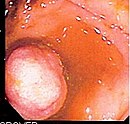Double balloon enteroscopy


The double balloon enteroscopy (DBE) is an endoscopic examination method from the field of gastroenterology , with the small intestine can be examined.
The principle of double balloon enteroscopy is to thread the small intestine through the use of two balloons on an approx. 2 meter long endoscope and a tube placed over it (so-called overtube ). The DBE can as a gastroscopy ( gastroscopy carried out) via the mouth ( upper DBE ) or as a colonoscopy ( colonoscopy ) through the anus ( lower DBE ). In order to be able to examine the entire small intestine, an upper DBE and a lower DBE usually have to be combined, usually on two consecutive days. The upper half of the small intestine is then examined through the oral access route, and the lower half of the small intestine is examined through the anal access route.
As part of the examination, tissue samples can be taken from the small intestine, polyps removed and z. B. bleeding small vascular malformations ( angiodysplasia ) are obliterated ( argon plasma coagulation ).
An alternative examination method for examining the small intestine is capsule endoscopy . It is currently still controversial in which situation which of the two methods for examining the small intestine should be preferred. A disadvantage of capsule endoscopy, however, is that no tissue samples ( biopsies ) can be taken and no therapeutic interventions are possible.
Web links
- Review article. (PDF; 523 kB) In: Ärzteblatt Rheinland-Pfalz , August 2007